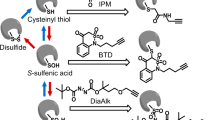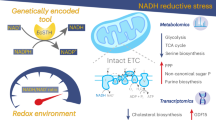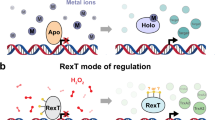Abstract
Isozyme-specific post-translational regulation fine tunes signaling events. However, redundancy in sequence or activity renders links between isozyme-specific modifications and downstream functions uncertain. Methods to study this phenomenon are underdeveloped. Here we use a redox-targeting screen to reveal that Akt3 is a first-responding isozyme sensing native electrophilic lipids. Electrophile modification of Akt3 modulated downstream pathway responses in cells and Danio rerio (zebrafish) and markedly differed from Akt2-specific oxidative regulation. Digest MS sequencing identified Akt3 C119 as the privileged cysteine that senses 4-hydroxynonenal. A C119S Akt3 mutant was hypomorphic for all downstream phenotypes shown by wild-type Akt3. This study documents isozyme-specific and chemical redox signal–personalized physiological responses.
This is a preview of subscription content, access via your institution
Access options
Access Nature and 54 other Nature Portfolio journals
Get Nature+, our best-value online-access subscription
$29.99 / 30 days
cancel any time
Subscribe to this journal
Receive 12 print issues and online access
$259.00 per year
only $21.58 per issue
Buy this article
- Purchase on Springer Link
- Instant access to full article PDF
Prices may be subject to local taxes which are calculated during checkout




Similar content being viewed by others
References
Lanning, B.R. et al. A road map to evaluate the proteome-wide selectivity of covalent kinase inhibitors. Nat. Chem. Biol. 10, 760–767 (2014).
Cohen, P. Protein kinases—the major drug targets of the twenty-first century? Nat. Rev. Drug Discov. 1, 309–315 (2002).
Dar, A.C. & Shokat, K.M. The evolution of protein kinase inhibitors from antagonists to agonists of cellular signaling. Annu. Rev. Biochem. 80, 769–795 (2011).
Gonzalez, E. & McGraw, T.E. The Akt kinases: isoform specificity in metabolism and cancer. Cell Cycle 8, 2502–2508 (2009).
Mochly-Rosen, D. & Gordon, A.S. Anchoring proteins for protein kinase C: a means for isozyme selectivity. FASEB J. 12, 35–42 (1998).
Tsai, Y.H., Essig, S., James, J.R., Lang, K. & Chin, J.W. Selective, rapid and optically switchable regulation of protein function in live mammalian cells. Nat. Chem. 7, 554–561 (2015).
Long, M.J., Poganik, J.R. & Aye, Y. On-demand targeting: investigating biology with proximity-directed chemistry. J. Am. Chem. Soc. 138, 3610–3622 (2016).
Gunning, P., Weinberger, R., Jeffrey, P. & Hardeman, E. Isoform sorting and the creation of intracellular compartments. Annu. Rev. Cell Dev. Biol. 14, 339–372 (1998).
Mann, M. & Jensen, O.N. Proteomic analysis of post-translational modifications. Nat. Biotechnol. 21, 255–261 (2003).
Parvez, S. et al. Substoichiometric hydroxynonenylation of a single protein recapitulates whole-cell-stimulated antioxidant response. J. Am. Chem. Soc. 137, 10–13 (2015).
Lin, H.Y., Haegele, J.A., Disare, M.T., Lin, Q. & Aye, Y. A generalizable platform for interrogating target- and signal-specific consequences of electrophilic modifications in redox-dependent cell signaling. J. Am. Chem. Soc. 137, 6232–6244 (2015).
Schopfer, F.J., Cipollina, C. & Freeman, B.A. Formation and signaling actions of electrophilic lipids. Chem. Rev. 111, 5997–6021 (2011).
Wang, C., Weerapana, E., Blewett, M.M. & Cravatt, B.F. A chemoproteomic platform to quantitatively map targets of lipid-derived electrophiles. Nat. Methods 11, 79–85 (2014).
Jacobs, A.T. & Marnett, L.J. Systems analysis of protein modification and cellular responses induced by electrophile stress. Acc. Chem. Res. 43, 673–683 (2010).
Parvez, S. et al. T-REX On-demand redox targeting in live cells. Nat. Protoc. 11, 2328–2356 (2016).
Fang, X. et al. Temporally controlled targeting of 4-hydroxynonenal to specific proteins in living cells. J. Am. Chem. Soc. 135, 14496–14499 (2013).
Manning, B.D. & Cantley, L.C. AKT/PKB signaling: navigating downstream. Cell 129, 1261–1274 (2007).
Dummler, B. & Hemmings, B.A. Physiological roles of PKB/Akt isoforms in development and disease. Biochem. Soc. Trans. 35, 231–235 (2007).
Wani, R. et al. Isoform-specific regulation of Akt by PDGF-induced reactive oxygen species. Proc. Natl. Acad. Sci. USA 108, 10550–10555 (2011).
Tschopp, O. et al. Essential role of protein kinase B-γ (PKB-γ/Akt3) in postnatal brain development but not in glucose homeostasis. Development 132, 2943–2954 (2005).
Poduri, A. et al. Somatic activation of AKT3 causes hemispheric developmental brain malformations. Neuron 74, 41–48 (2012).
Chen, C.T., Green, J.T., Orr, S.K. & Bazinet, R.P. Regulation of brain polyunsaturated fatty acid uptake and turnover. Prostaglandins Leukot. Essent. Fatty Acids 79, 85–91 (2008).
Akbar, M., Calderon, F., Wen, Z. & Kim, H.-Y. Docosahexaenoic acid: a positive modulator of Akt signaling in neuronal survival. Proc. Natl. Acad. Sci. USA 102, 10858–10863 (2005).
Gao, X. & Zhang, J. Spatiotemporal analysis of differential Akt regulation in plasma membrane microdomains. Mol. Biol. Cell 19, 4366–4373 (2008).
Zhou, B.P. et al. HER-2/neu blocks tumor necrosis factor-induced apoptosis via the Akt/NF-κB pathway. J. Biol. Chem. 275, 8027–8031 (2000).
Dudek, H. et al. Regulation of neuronal survival by the serine-threonine protein kinase Akt. Science 275, 661–665 (1997).
Papa, A. et al. Cancer-associated PTEN mutants act in a dominant-negative manner to suppress PTEN protein function. Cell 157, 595–610 (2014).
Kardash, E., Bandemer, J. & Raz, E. Imaging protein activity in live embryos using fluorescence resonance energy transfer biosensors. Nat. Protoc. 6, 1835–1846 (2011).
Long, M.J.C. & Aye, Y. The die is cast: precision electrophilic modifications contribute to cellular decision making. Chem. Res. Toxicol. 29, 1575–1582 (2016).
Liew, W.C. & Orbán, L. Zebrafish sex: a complicated affair. Brief. Funct. Genomics 13, 172–187 (2014).
Kolb, H.C., Finn, M.G. & Sharpless, K.B. Click chemistry: diverse chemical function from a few good reactions. Angew. Chem. Int. Edn Engl. 40, 2004–2021 (2001).
Yang, Y., Thannhauser, T.W., Li, L. & Zhang, S. Development of an integrated approach for evaluation of 2-D gel image analysis: impact of multiple proteins in single spots on comparative proteomics in conventional 2-D gel/MALDI workflow. Electrophoresis 28, 2080–2094 (2007).
Yang, Y. et al. Evaluation of different multidimensional LC-MS/MS pipelines for isobaric tags for relative and absolute quantitation (iTRAQ)-based proteomic analysis of potato tubers in response to cold storage. J. Proteome Res. 10, 4647–4660 (2011).
Hochrainer, K., Racchumi, G., Zhang, S., Iadecola, C. & Anrather, J. Monoubiquitination of nuclear RelA negatively regulates NF-κB activity independent of proteasomal degradation. Cell. Mol. Life Sci. 69, 2057–2073 (2012).
Acknowledgements
We thank J. Fetcho and B. Miller (Cornell University) for scientific and technical guidance on zebrafish studies; J. Zhang (University of California, San Diego) and Johns Hopkins University for providing AktAR reporter plasmid; J. Poganik for his initial contributions to zebrafish studies; the zebrafish husbandry and microinjection/imaging facility (NIH R01 NS026593, J. Fetcho (Cornell University)), the Cornell NMR facility (NSF MRI: CHE-1531632, Y.A.), the Cornell Imaging Center (NIH 1S10RR025502, R.M. Williams (Cornell University)) and the Cornell proteomics and MS facility (NIH 1S10RR025449-01, S.Z.) for instrumentation. Supported by NIH New Innovator (1DP2GM114850), Beckman Young Investigator, NSF CAREER (CHE-1351400), Burroughs Wellcome CRTG and Sloan Fellowship programs (to Y.A.); HHMI predoctoral fellowship (59108350 to S.P.) and a Hill undergraduate fellowship (to S.L.S.) for student support.
Author information
Authors and Affiliations
Contributions
M.J.C.L., S.P. and Y.A. designed the experiments. M.J.C.L. performed in vivo experiments in fish embryos. S.P. and M.J.C.L. performed cell-based experiments and collected the biochemical data from fish samples. Y.Z. and Y.W. performed chemical synthesis. S.L.S. assisted M.J.C.L. and S.P. with gene cloning and protein purification. S.Z. assisted in LC-MS/MS data analysis. M.J.C.L., S.P. and Y.A. analyzed and interpreted the data. Y.A. wrote the paper with editing contributions from M.J.C.L. and S.P.
Corresponding author
Ethics declarations
Competing interests
The authors declare no competing financial interests.
Supplementary information
Supplementary Text and Figures
Supplementary Results, Supplementary Tables 1–4 and Supplementary Figures 1–18. (PDF 4926 kb)
Rights and permissions
About this article
Cite this article
Long, M., Parvez, S., Zhao, Y. et al. Akt3 is a privileged first responder in isozyme-specific electrophile response. Nat Chem Biol 13, 333–338 (2017). https://doi.org/10.1038/nchembio.2284
Received:
Accepted:
Published:
Issue Date:
DOI: https://doi.org/10.1038/nchembio.2284
This article is cited by
-
Z-REX: shepherding reactive electrophiles to specific proteins expressed tissue specifically or ubiquitously, and recording the resultant functional electrophile-induced redox responses in larval fish
Nature Protocols (2023)
-
Genetically encoded formaldehyde sensors inspired by a protein intra-helical crosslinking reaction
Nature Communications (2021)
-
Wdr1 and cofilin are necessary mediators of immune-cell-specific apoptosis triggered by Tecfidera
Nature Communications (2021)
-
Taking AKTion on HNEs
Nature Chemical Biology (2017)



